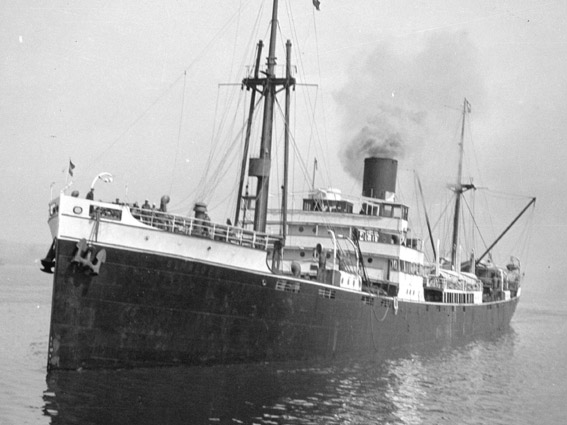
| |
 |
|
Tony Ortzen
|
“Some years ago,” writes Tony Ortzen, “I began a book about animals, looking, for example, at their spirit returns and various other angles. Unfortunately, I’ve never had time to finish it.
“Here, owners tell how their lost pets braved oceans, mountains, seas, rivers and deserts to reach home after becoming lost, sometimes travelling hundreds and thousands of miles.”
MANY of us have known the anguish of losing a pet if only for a day or two.
Generally, they come romping home to be greeted joyously by their anxious owners.
Some pets go missing for months, even years. Not only that, but there are countless cases throughout the world of animals journeying thousands of miles – often across hostile terrain and even oceans – to return home using some kind of psychic radar.
First, let’s examine a perplexing subject: do humans also have some kind of inbuilt faculty, which acts as a direction finder? One answer came from Dr Robin Baker, of Manchester University, whose study involved more than 400 volunteers.
Over a period of time, they were blindfolded and taken by car via a complicated route to locations between three and 30 miles from the university’s zoology department.
Still unable to see, the volunteers were then asked to point towards the direction of the university. Next, the blindfolds were taken off and the subjects asked to repeat the test.

“We thought that people would make better guesses when the blindfolds were removed,” said Dr Baker, “but the opposite happened.
“Most people could not explain why they chose a particular direction. They said it just seemed to feel right.” It transpired that the sun’s warmth and direction made no difference. On overcast and cold days the same findings were produced as on sunny ones.
In another battery of tests, half the volunteers wore helmets containing magnets. In the others’ helmets were dummy magnets.
The results were startling. Those wearing real magnets became totally disorientated, but volunteers with dummies had a good idea of the correct direction.
To Dr Baker, the tests “have proved that man does have a magnetic sense of direction. The discovery of a new sense is intensely exciting.
“The race is on to make discoveries that will raise our understanding and increase our knowledge of this new power.” One of the most astonishing accounts of an animal being reunited with its owner revolves around a terrier named Hector, whose owner was Willem Mante, master of the Dutch freighter SS Simaloer.
Hector always ran loose when the ship was in port, but faithfully returned to the vessel before it set sail.
The dreaded day came when a frantic and saddened Mr Mante realised that Hector had been left behind as the SS Simaloer sailed from Vancouver harbour in Canada for Japan. He reconciled himself to the fact that he would never see his beloved companion again.

|
|
|
Dutch freighter SS Simaloer
(Photo: Walter E. Frost)
|
|
The next morning, an officer on another Vancouver-docked ship, the SS Hanley, noticed a wire-haired terrier walk up the gangplank.
“He looked as if he was on a mission, not just wandering about,” said the officer.
“After trotting around the deck, he went below to sniff at our cargo and then left.” Other seamen noticed the dog investigate three other ships. It was only when the Yokohama-bound SS Hanley was two hours out of port that the crew found Hector aboard.
Nineteen days later, as they approached Japan, the canine stowaway became increasingly restless, quivering with excitement as the SS Hanley entered Tokyo Bay.
As the cargo was being unloaded, another vessel moved into a berth about 300 yards away. A group of sailors from the newly arrived boat sailed in a sampan near the SS Hanley’s stern.
As the small craft approached, Hector began to whine with excitement. Suddenly, the plucky pet jumped into the water a few feet from the sampan, swam to it and was pulled aboard. Helping to do so was Willem Mante – the one for whom Hector had literally crossed an ocean.
But why did he choose the Japan-bound ship instead of other vessels moored in Vancouver? “There is no logical explanation,” admitted Mr Mante. “We cannot account for it, but only marvel at the fact that it really happened.” There is also a nautical flavour concerning Spook, a white German Shepherd dog, who lived in Sacramento, California. Travelling with his owner, Christine Rowe and her son, he vanished overboard from the Seattle to Alaska ferry.
Spook was presumed drowned in the icy sea near to Vancouver Island, Canada, for there seemed no other logical outcome… or that he would ever be seen alive again.
Yet he was. Against overwhelming odds, Spook swam and walked back to his home town.
|
 |
|
|
The next morning, an officer on another
Vancouver-docked ship, the SS Hanley,
noticed a wire-haired terrier walk
up the gangplank.
|
This involved crossing to the mainland, travelling down a long stretch of Canadian coastal wilderness, perhaps through the densely populated cities of Seattle, Tacoma and Portland, then facing the rugged Siskiyou Mountains.
Incredibly, three months after he went missing, on October 6, 1976, Spook arrived about a mile from his home “dehydrated, half-starved and lying exhausted by the side of a freeway.” Local resident Bernadine Sullivan took him in, recalling that Spook “drank about a gallon of water. For three days, he just lay there and ate and drank. He was so exhausted.” Bernadine advertised the dog’s find in various newspapers, but received no replies. Spook stayed with her for a month, but one day did not return from his nightly walk.
A further four months elapsed until Spook was seen again, this time in a Sacramento dog pound. Yet the incredible story did not end there, for Christine Rowe, looking for her brother’s lost dog, walked in.
Startled at seeing a white German Shepherd, she very tentatively called out “Spook?” He recognised her instantly.
“I still cannot believe it,” said a thrilled Christine. “I had given up hope of ever finding him again.” So, too, had the owners of Nick, another German Shepherd, who travelled 2,000 miles in four months to return to her owner. The five-year-old pet was owned by the Simpson family, of Selah, Washington.
The drama began when she accompanied Doug, the Simpson’s 27-yearold son, on a camping trip. The last time Doug saw Nick was when they were camped deep in the southern Arizona desert.
He awoke one morning to find that the pet had vanished. Despite a frantic twoweek search, Doug could find no trace of her.
Had she wandered into the desert to hunt and temporarily lost her bearings? No one knew. What was for certain was that the desert was often scorching with no water.
Yet somehow Nick survived, making her way hundreds of miles through barren scrubland. Possibly, she encountered the Grand Canyon and its deep chasms.
No matter which route she took, the climatic conditions would have changed dramatically.
For example, in Nevada and Oregon Nick must have braved and survived blizzards, icy rivers and almost impassable mountains, some reaching nearly 12,000 feet. Then she had to cross Washington State before making the final 60 miles to Selah.
When she arrived, not surprisingly Nick was half-starved and bedraggled.
She staggered into the driveway of the Simpson’s suburban home and slumped down, totally exhausted, by son Doug’s old Volkswagen.
Nick’s paws were covered in blood, with her ribs sticking out awkwardly from beneath the thoroughly matted coat. Her face was thin and battered, yet recognisable to Mrs Simpson, who found the pet by Doug’s vehicle.
She shouted to her husband, who came running. Gently examining the dog’s head, he found an old telltale scar, saying, “It’s impossible, but it’s Nick!” By that point, Doug was working as an instructor at a childcare centre in Pennsylvania. He raced home immediately after receiving a call from his parents to say that Nick had returned.
“I came into the house,” Doug recalled.
|
 |
|
|
WITH dogged determination, one German
Shepherd dog travelled 2,000 miles
in four months to return to her owner.
|
“Nick looked up at me. For just a few seconds she remained still. It was as if she were saying: ‘You left me. I have been through hell getting home, so that you can see me again.’ “Then she came to me, pushed her muzzle up against my hand and wagged her tail. I have been making a fuss of her ever since!” Bobbie, a mixed breed pet, travelled even further than Nick, clocking up an amazing 3,000 miles to rejoin her owner.
Part English sheepdog, Bobbie became involved in a fight with a bull terrier while his owner was having his car repaired at a garage in a town in Indiana thousands of miles from home.
Bobbie gave as good as he got until two other dogs joined in the fight. Then he ran away.
Hours later, Bobbie returned to the garage to find that his owner had given up hope of finding him and left for home in far off Oregon.
That’s when Bobbie’s amazing trek began – a trek that must have involved crossing mountains, rivers and deserts. It is believed that to cross the Missouri, Bobbie swam between huge blocks of ice.
Reaching Oregon six months later, like Nick on her epic journey, Bobbie’s paws were bleeding and raw, and he was skeleton thin.
What contributes added authenticity to this case is that Colonel E. Hofer, of America’s Oregon Humane Society, managed to locate people who remembered giving Bobbie temporary shelter and others who took pity and fed him during his journey.
Keeno, a two-year-old, also became lost in a desert – this one in Idaho – whilst helping her owner, rancher Van Price, to round up stray cattle. Frantically he tried to track her, but without success.
Mr Price despaired of ever seeing Keeno again. “There’s nothing out there but sage, lava, rattlesnakes and coyotes,” he said. “The only water is the Lost River.” However, Mr Price began receiving calls from fellow ranchers who had spotted Keeno, but she would not stop.
Unfortunately, her foreleg became caught in a coyote trap, its vicious steel jaws almost biting through her bone. Somehow, the plucky dog managed to break the chain holding it to a stake.
It took Keeno 120 days to travel 50 miles to Butte City, Idaho. Limping down a street, she was seen by some children and given food. Feeling a touch more confident, eventually she allowed some of them to get close enough to remove the trap.

|
|
|
The rugged Siskiyou Mountains, California
(Photo: Chris M Morris)
|
|
Mr Price’s brother was contacted by the city mayor. He fetched the dog and drove her the final twenty miles home.
An overjoyed owner called to Keeno the moment he saw his brother’s van. Though her leg was shattered, Keeno still managed to jump out to greet him.
No matter where one looks in the world, there are many cases of cats and dogs undertaking almost unbelievable journeys of endurance to be reunited with their owners, surviving against incredible odds.
Feline feats are equally as amazing. Take Silky, a ginger tom, who went caravanning with his owners Mr and Mrs Ken Phillips in Gin Gin, about 188 miles north of Brisbane, the capital of Queensland.
The couple let him out one night – and did not see Silky until nine months later at their home in Reservoir, a Melbourne suburb.
“He was as thin as a whip and stank to high heaven,” said Mr Phillips, “but when I called his name, his eyes lit up and he started purring.” And the length of his trip? A staggering 1,184 miles.
Back in Britain, a cat called Samson journeyed from the wilds of Wales to the small house in London’s bustling East End which was once his home.
Margaret Adams had long since given up all hope of finding him after Samson became lost during a caravan holiday. She advertised his details all over Pembrokeshire, but to no avail.
Mrs Adams was in her garden dealing with some washing when she saw a bedraggled bundle of ginger fur sitting on the wall at the back of her house in Upper Road, Plaistow.
“There was something about him,” she said, “but after two years I thought it could not really be Samson.” She called out the name of Samson and he came.
After Mrs Adams picked him up, “he just lay back in my arms and purred.” What’s more, the cat that wandered into her garden had the same tiny white patch at the base of his stomach, and was small, with fat legs. He walked in exactly the same way as Samson.
Mrs Adams was adamant it was the same cat as “he has all the same mannerisms as well, which any cat owner would recognise in her own animal. There was always something very special about him.” Now to East Sussex and to Sharni, a Siamese cat, whose owners, Brian James and his wife, moved from their home in Chailey, near Brighton, to Glyn Ceiriog in north-east Wales.
Mrs James kept the cat inside for a few weeks, so she could get used to her new house. When finally let out, she disappeared.

|
|
|
AFTER her owners moved from East Sussex to
north-east Wales, a Siamese cat somehow made
her way back to near her previous home 250 miles
away and was adopted by a former neighbour.
|
|
Twenty months later, Dorothy Thorne, who lived near the James’ former home, saw a Siamese cat wandering in an adjacent field. As it resembled Sharni so closely, she telephoned Mrs James, only then learning about her disappearance.
Sharni was in bad shape following her 250-mile hike, but soon recovered and “adopted” Mrs Thorne. Mrs James travelled back to Chailey to identify Sharni, deciding to let her stay.
“It is fantastic,” she commented. “If anyone saw her during this time we would like to find out exactly where. Maybe she spent the winter with someone.” Mrs Thorne termed the cat’s journey “extraordinary,” adding, “I cannot think how she got across the motorways and rivers.” So there you have it – evidence aplenty that against all the odds, loyal dogs and cats possess a remarkable ability to return to those they love.
|

